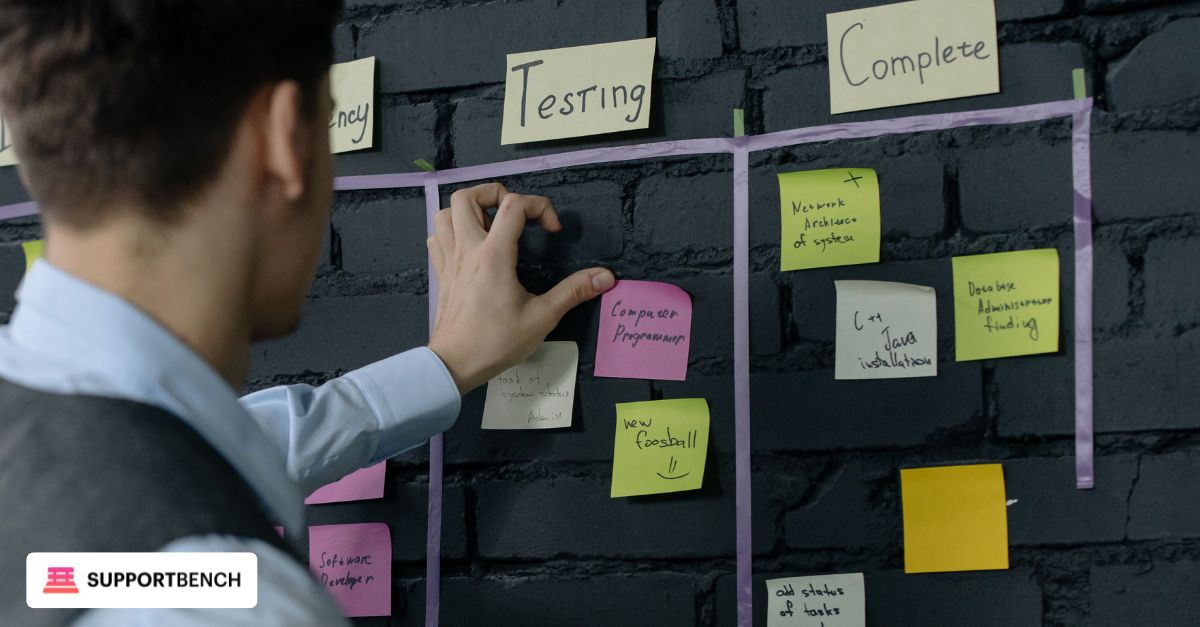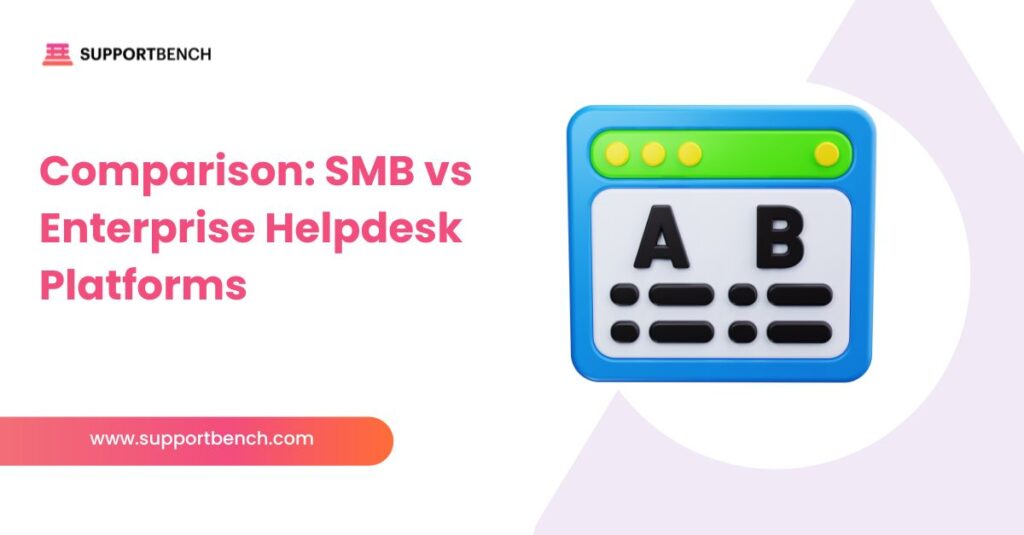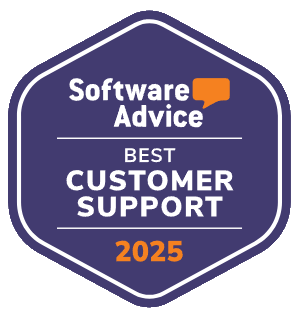Helpdesk platforms are the backbone of modern customer service. But not all teams operate at the same scale. A tool that fits a 10-person team may falter under the demands of a multinational organization—while enterprise-grade systems can overwhelm smaller companies with complexity and cost.
Small and medium-sized businesses (SMBs) and large enterprises face different challenges, work with different resources, and prioritize different outcomes.
This guide compares helpdesk platforms based on these differences—so you can choose a system that not only supports where you are today but grows with you over time.
Here is the Quick Answer:
SMBs and enterprises need different helpdesk solutions. SMBs value fast setup, ease of use, and low cost. Enterprises require scalability, advanced security, deep customization, and formal SLAs. The best platform adapts to your current size and future goals—Supportbench fits both by offering AI-powered support, ticket automation, SLA tracking, and omnichannel support.
Core Objectives: SMB vs Enterprise Helpdesk Tools
Small and mid-sized businesses (SMBs) typically seek helpdesk platforms that are easy to use, fast to deploy, and cost-effective. Most work with limited IT resources and need tools that deliver value immediately, without complex setup.
Enterprises, by contrast, prioritize platforms that offer scalability, granular control, and deep customization. Their operations involve complex workflows, regulatory requirements, and multiple teams across regions.
Here’s a side-by-side breakdown:
| Category | SMB | Enterprise |
| Key Focus | Ease of Use, Speed, Affordability | Scalability, Compliance, Customization |
| Budget Sensitivity | High | Medium |
| IT Resources | Limited or Shared | Dedicated Teams |
| Decision Making | Owner or Small Team | Procurement + IT Departments |
These contrasting needs shape every other decision—especially around setup, integrations, and long-term support expectations.
Setup and Onboarding
For SMBs, helpdesk setup is designed to be quick and easy. Many platforms offer plug-and-play onboarding, guided tutorials, and pre-configured templates. Most SMB solutions are cloud-based, allowing teams to get started within hours—often without IT involvement.
Enterprise onboarding, however, is more layered. It typically includes integration with CRMs, ERPs, or custom internal systems. This process may span several weeks or months and often involves pilot testing, role-specific training, and alignment with security and compliance frameworks.
While SMBs prioritize speed and simplicity, enterprises invest upfront to build a system tailored to their operations and governance policies.
Scalability and Growth
SMBs typically grow step by step. Most begin with a few agents and gradually expand. They need platforms that scale smoothly—adding users, automating tasks, and growing features as needed. Tools like ticket automation and AI-powered support help these small teams handle rising workloads without adding headcount.
In contrast, enterprise organizations scale fast. They grow across regions, departments, and time zones. Their helpdesk must support high ticket volumes, real-time collaboration, and granular user permissions.
Scalability at this level requires robust infrastructure. Enterprise teams depend on automation to manage complexity and maintain service speed at scale.
Supportbench adapts to both types of growth—offering lightweight scalability for SMBs and enterprise-grade power when it’s needed.
Workflow Complexity: Simplicity vs Sophistication
SMBs usually prefer simple automation. They benefit from rules that auto-assign tickets based on keywords or close inactive requests after a certain time. These workflows boost speed and consistency without requiring technical setup.
Enterprises operate on a different scale. Their helpdesk processes may involve multiple support tiers, department-specific approvals, and compliance reviews.
To support this, the platform must offer conditional logic, event-based triggers, and deep integrations with systems like HR, legal, or IT.
Supportbench supports both ends—offering user-friendly workflow builders for SMBs and advanced rule engines for complex enterprise use cases.

Customization: Pre-Built Features vs Unique Solutions
SMBs typically prefer ready-made solutions with just enough flexibility to personalize the interface. Most need only light customization—like adjusting dashboards, creating canned responses, or selecting a support theme. This simplicity keeps maintenance low and avoids technical overhead.
Enterprises, however, expect full control. They may need branded customer portals, custom data fields, role-specific dashboards, and the ability to build new objects or modules via API.
Supportbench accommodates both. It provides quick-start customization options for growing teams, while also enabling deep personalization for complex organizations through extensible architecture.
Security and Compliance: Protecting Data and Meeting Standards
Security expectations rise with business size—and helpdesk platforms must keep pace. Whether serving hundreds or thousands of users, your system needs to safeguard sensitive data, align with regulatory demands, and ensure authorized access at every level.
Data Protection
Scalable helpdesk systems must encrypt data both in transit and at rest. SMBs typically benefit from standard protections like HTTPS and role-based access, while enterprises need more advanced options like field-level encryption and audit logs.
Secure hosting environments, regular penetration testing, and data backup protocols are also essential. These measures build trust with users and protect against breaches that can disrupt operations or lead to liability.
Compliance Needs
Compliance varies by industry. SMBs may only need to follow basic frameworks like GDPR or CCPA, but enterprise organizations must often meet HIPAA, SOC 2, ISO 27001, or sector-specific standards in finance, healthcare, or government.
A helpdesk platform should make it easy to configure policies around data retention, customer consent, and incident response. Built-in tools for documenting access history and ensuring audit readiness help maintain ongoing compliance.
Authentication and Access Controls
User authentication should match the size and complexity of your team. While smaller companies may rely on two-factor authentication (2FA), enterprises often require SAML, LDAP, or OAuth integrations for centralized credential management.
Granular access controls help define who can view, edit, or export data across departments or roles. Combined with real-time monitoring, these features ensure that support data stays in the right hands—and out of the wrong ones.
Analytics and Reporting: Turning Data Into Strategy
Effective support operations depend on visibility. From small team management to coordinating global departments, both real-time insights and long-term trends are essential for driving continuous improvement.
For SMBs, simple dashboards that track ticket volume, resolution times, and customer satisfaction scores help identify patterns and pain points. These baseline metrics support everyday decisions and improve accountability.
Enterprises need a deeper layer. Customizable dashboards, departmental breakdowns, historical analysis, and SLA tracking allow larger teams to measure success against service goals. Integrations with business intelligence tools further enrich decision-making by linking support data with broader company KPIs.
Ultimately, the goal is the same at any scale: use clear data to improve team performance, resource allocation, and customer satisfaction.

Integrations and Ecosystem: Connecting to the Tools You Use
A helpdesk doesn’t operate in isolation—it’s part of a larger system of tools, processes, and teams.
For SMBs, integrations typically focus on a few essentials: email, calendars, CRMs, or team chat tools. These connections simplify daily workflows and reduce context switching, making life easier for smaller teams with limited IT resources.
Enterprise platforms, on the other hand, require far-reaching integrations. From ERPs to custom-built internal systems, they must support APIs, webhooks, and middleware to ensure compatibility and data flow across business units.
Supportbench addresses both ends of the spectrum by offering flexible, open APIs and out-of-the-box integrations. This makes it easier to adapt the platform to your existing stack—whether you’re a lean startup or a global organization.
Support Expectations and SLA Commitments
For SMBs, responsive and friendly customer service—often via email or live chat—is usually enough. While formal guarantees might be rare, what matters most is that help is quick and helpful when needed.
Enterprise clients operate under higher stakes. Downtime can result in SLA violations, compliance issues, or lost revenue. As a result, they expect 24/7 support, structured escalation paths, and guaranteed resolution timelines.
This is where robust SLA tracking features become essential. Platforms like Supportbench provide built-in tools to monitor compliance, trigger breach alerts automatically, and keep resolutions within defined service windows. These tools support both basic service promises and complex, multi-tiered agreements as teams grow.
Pricing Models
SMBs often work within strict budgets and prefer predictable pricing. Simple, transparent plans—such as per-agent pricing or usage-based tiers—make it easier to forecast costs without surprises. These businesses benefit from straightforward onboarding and low upfront commitments.
Enterprises, on the other hand, tend to negotiate contracts based on scale, compliance needs, and custom features. Their pricing often reflects bundled services like dedicated support, SLA tracking, audit tools, and integrations. Flexibility in licensing—such as unlimited agents or volume discounts—can make a major difference.
Supportbench adapts to both ends of the spectrum, offering flexible pricing tailored to business size and maturity. From five-agent startups to enterprise-wide deployments, there’s a model designed to fit.
Collaboration and Team Roles
SMBs often rely on small, flexible teams. A single agent might handle a wide range of tickets—technical, billing, onboarding—all in the same day. Collaboration tools need to be simple. Internal notes, tagging, and shared inboxes help avoid confusion and speed up resolution.
Enterprises run on structure. Roles are clearly defined: frontline agents handle basic inquiries, technical teams resolve complex issues, and QA staff monitor quality. Operations and analytics teams may also manage workflows and performance reporting.
Supportbench supports both models. Small teams benefit from lightweight features like team mentions and collision alerts. Larger organizations can use permission settings, queue segmentation, and audit logs to manage complex collaboration needs without losing visibility.

How to Choose Based on Company Size
Your helpdesk needs depend heavily on the size and structure of your team. Here’s how to evaluate options based on where your organization stands:
Small Teams (Under 50 Users)
Look for tools that prioritize simplicity and ease of use. Fast onboarding, basic automation, and a clear UI help lean teams stay productive without needing IT support.
Medium-Sized Businesses (50–300 Users)
As teams grow, reporting and multi-channel capabilities become essential. Choose platforms that offer foundational [ticket automation], real-time dashboards, and multilingual options.
Mid-Market / B2B (100–1,000 Users)
You’ll need more robust workflows—like SLA tracking, AI summaries, and CRM integration. Supportbench’s scalable feature set meets these demands without the overhead of enterprise pricing.
Large Enterprises (1,000+ Users)
Seek advanced tools for compliance, custom development, and organizational oversight. Supportbench delivers these enterprise-grade capabilities while still offering flexibility and cost transparency.
Implementation Tips
Rolling out a new helpdesk platform is more than a software switch—it’s a shift in how your team supports customers. Tailor your rollout approach to your organization’s scale:
SMBs
Focus on guided onboarding and user-friendly interfaces. The faster your team adopts the platform, the quicker you’ll see ROI.
Enterprises
Map out internal processes in detail. Avoid over-engineering by involving users early and testing workflows before full deployment.
All Teams
Establish clear success metrics upfront. Whether you’re aiming for faster resolution times, better SLA compliance, or smoother collaboration, knowing what success looks like helps guide configuration and evaluation.

Future Readiness
Your helpdesk platform should keep pace as your business evolves. Growth brings new demands—more customers, more channels, more compliance requirements. The right system anticipates these shifts.
For SMBs, future readiness means scaling without added complexity. Look for modular platforms that expand feature sets gradually as your team grows.
For enterprises, staying ahead requires systems that can handle regulatory updates, global operations, and new technologies. Built-in flexibility helps avoid disruptive transitions later.
Features like AI-powered support, real-time SLA tracking, sentiment detection, and omnichannel support aren’t optional anymore—they’re the baseline for responsive, modern service.
Platforms like Supportbench are built for long-term adaptability, offering the features you need now, and the capacity to grow into what’s next.
Conclusion
Small businesses and enterprises have different support needs because they face different challenges. SMBs prioritize simplicity, low cost, and tools that are easy to adopt. Enterprises, on the other hand, need platforms that can manage high volumes, strict compliance, and complex workflows.
The right helpdesk platform should meet your current needs while preparing you for growth. It should adapt to your processes, scale without friction, and support excellent service delivery at every stage.
Supportbench delivers on both fronts. It gives small teams the tools to work smarter and helps large organizations maintain clarity, control, and service quality at scale.















